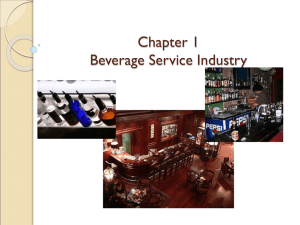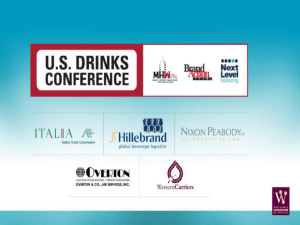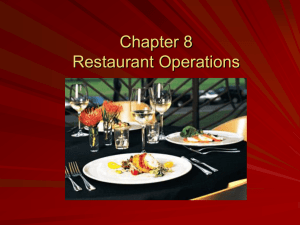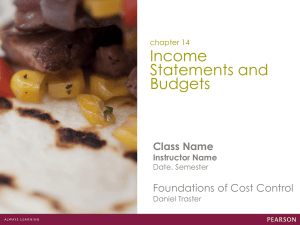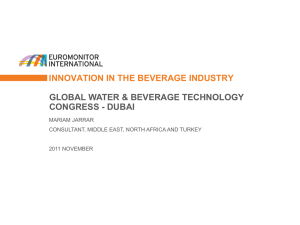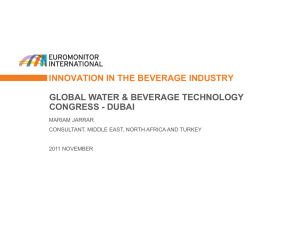Lesson 10 - Beverage Control Systems
advertisement
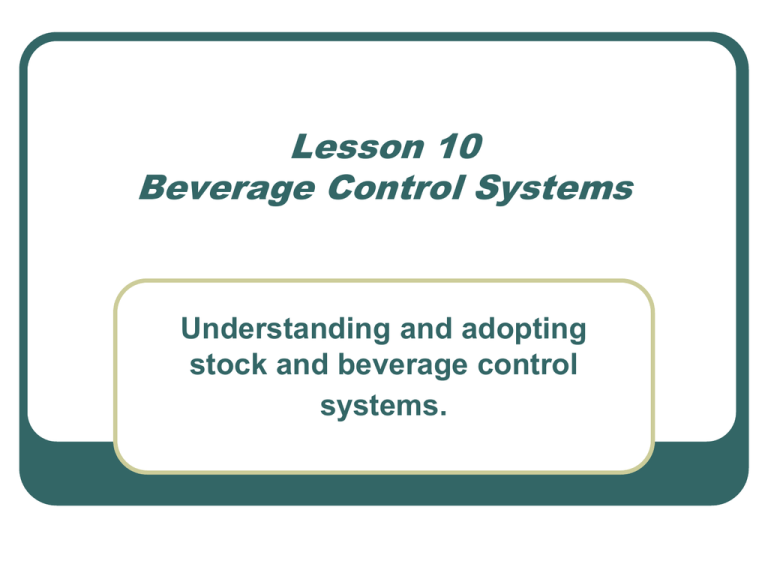
Lesson 10 Beverage Control Systems Understanding and adopting stock and beverage control systems. Lesson 10: Beverage Control Systems Lesson Overview 10.1 Introduction 10.2 Managing costs and revenue to make profits 10.3 Policies for pricing 10.4 Stock control 10.5 Receiving, checking, storing and issuing controls 10.6 System of bar books 10.7 Cellar management 10.8 Control of possible losses in the bar 10.9 Controls for beverage production 10.10 Point-of-sale systems for stock and beverage control Conclusion References Lesson 10: Beverage Control Systems Aims and Learning Outcomes of the Lesson On completion of this lesson the learner will be expected to be able to; Identify the major planning areas involved to manage costs, pricing and revenue for achieving profits. Apply the controls, techniques and documentation for receiving, storing and issuing products. Outline the rationale and procedures for stock control in bars Explain the point of sale systems used for stock and beverage control in bars. Lesson 10: Beverage Control Systems 10.1 Introduction There are many benefits for having specific procedures for the control and recording of stock and beverages in your bar premises. Operating a regular and rigorous system of stock taking and beverage control within your bar will help you to; control costs, achieve profit margins acceptable for the success of the business help you to identify problem areas in relation all the products, stocks, beverages etc of your bar business. Lesson 10: Beverage Control Systems 10.2 Managing costs and revenue to make profits Profit figures are not significant until they are expressed in relation to other elements Lillicrap & Cousins (2010) refer to these elements as ‘the relationship between the costs of running the operation, the revenue received and the profit made’. Understanding of these relationships is the key to fully comprehensive cost control in food and beverage operations. A plan for profit generation and financial sustainability Starting point: a good financial plan must include a monthly or annual budget with projections for expenditure and income. Try to be detailed, objective and realistic when formulating your projections of costs and revenue in relation to desired profit. Gather as much detail as possible and be flexible with adjustments before applying it to a future that might change before it arrives. The ideal method used to monitor your projections is Sales Projection sheet (Chapter 10 – table 10. p. 191). (use past trading accounts to project future sales) – this information is used to plan for the month/year ahead (i.e. more or less staff, new products and services, renovations). Project the Bar Expenses (Chapter 10 – table 10.2 p. 192 - provisional projected budget), your major expenses are classified as fixed and variable. Fixed costs: (ie.rent, insurance and taxes etc) Variable costs: (i.e. advertising, supplies, beverage costs, etc) Total the bar’s expenses and express them as a percentage of your projected sales for the bar for the month/year. To find the percent of your revenue (sales) which you pay for your expenses, divide the individual expense or total expense into the revenue (sales) figure. (Chapter 10 – Table 10.3 p. 194) Lesson 10: Beverage Control Systems 10.2 Managing costs and revenue to make profits (continued) Refining your budget – setting financial projections Understanding your bar’s financial situation allows you to plan for the upcoming months and year. Base your projections on previous annual or monthly profit and loss income statements. Highlighted Chapter 10 – p. 192 Table 10.3 - incorporate the changes and costs you envisage for the upcoming year Chapter 10 – p. 193 Table 10.2. Other financial projection tools Break even point Cash flow forecast Projecting profit levels Be realistic in your expectations, be creative when souring specific information (i.e. use contacts, friends, industry contacts). You should consider the following: business rates, overheads / costs, sales information, rent costs, profit and loss, income statements – see table 10.3 p. 194, private eye – local observations, trade patterns and values). Variable rate, contribution rate and break even point : These points play a pivotal role in the relationship between cost, revenue and profit in your bars performance. Variable rate (VR) calculation - Formula: VR = Variable cost divided by sales = VR% (18.100) / (50,000) = 0.362 or 36.2% 36.2% of every sale is needed to cover the variable costs. Remember bar sales and variable costs will rise simultaneously. Variable Cost calculation: Reverses the Variable rate calculation. If you know the variable rate, you can find the variable cost, by multiplying the total sales by the variable rate. Formula: (50,000) x 0.362 = 18,100 (variable cost) Lesson 10: Beverage Control Systems 10.2 Managing costs and revenue to make profits (continued) Variable rate, contribution rate and break even point (cont): Contribution rate / margin : If 36.2% of every dollar (or local currency) is required to cover the bar’s variable costs, then the remaining amount (63.8%) is commonly referrred to as the contribution rate. Contribution rate pays for (i.e. fixed costs and accepted profit levels). Contribution rate formula: 100 - 36.2% (variable rate) = 63.8% (contribution rate). Contribution margin formula: 50,000 – 18,100 = 31,900 (contribution margin). Break even Point (the level of operation at which total costs equal total sales which equals no profit or loss) Break even point formula: total fix costs / contribution rate = break even point 9,900 / 0.638 = 15,517 (This bar needs 15,517 each month just to break even). Further formulas for setting break even points (Chapter 10 – p. 196). Cash flow projections Cash does enter and exit your bar business at the same rate (money can be tied up in equipment) Cash flow forecast is a short term forecast of cash flowing into your bank and cash flowing out weekly or monthly To create this forecast consider the following (predict your total income, predict your total expenditure – fixed and variable costs, subtract your total income for your total expenditure to obtain the income less expenditure (costs) figure, enter separately below these figures figure for the cash at the start of the month and cash at the end of the month, complete this task each month for 12 months plus projections and you will meet your financial obligations when they fall due in future. Further information: Chapter 10 – p. 197 Sargent & Lyle (2003) contend that managing your cash flow is about having the right amount of money available in the right place at the right time. Lesson 10: Beverage Control Systems 10.3 Policies for pricing Policies for pricing food and beverages can differ from bar to bar. Lillicrap & Cousins (2010) maintain that irrespective of the method adopted, you should a clear pricing policy or objective in mind, these objectives can include; Sales volume maximisation, Market share gain, profit maximisation, market penetration (Chapter 10 - p. 198) When you have decided on the policy, you need to adopt the most suitable pricing method Pricing Methods Method 1: Gross Profit: expresses the amount of Gross profit realised on the sale of products and is determined by dividing the gross profit by the sales price. Gross Profit Formula: Gross Profit = Selling Price - Cost of drink 11.40 3.99 = 7.41 (gross profit) . Gross Profit margin formula: Gross profit margin = Gross Profit / Selling price 7.41 / 11.40 = 0.65, or 65% (gross profit margin) . Further examples for use: (Chapter 10 – p. 199). Method 2: Demand / Price relationship: Set your prices based on individual customers, the market place, local competition to stimulate demand. Create a balance across all food and beverage products to help drive good margins. Introduce prices incrementally and observe the changes to gauge the effect. Method 3: The cost /price relationship: Every bar must determine its own cost percentage to produce the profit needed. Sales Price = Total cost of ingredients divided by cost percentage 3.99 / 0.35 = 11.40 (sales price) Converting the cost percentage into a multiplier: 100% (Sales price) / 35% (cost percentage) = 2.857 (multiplier) 2.875 x 3.99 = 11.40 (sales price) Lesson 10: Beverage Control Systems 10.4 Stock Control Why do we count stock, well to calculate the sales figures for the bar, we also count the stock and beverages to calculate the cost of these sales and to determine the gross margins achieved on these sales. When we should count the stock?, preferably at the start or the end of the day’s trading, ideally when the bar is closed. The frequency of these counts really depend on the size of your bar. Further information: (chapter 10 – pp. 200-201 Regular stock control can provide information which is vital to highlighting poor controls Stock Control Helps the Bar to: Eliminate over stocking (insurance problems, tying up money), eliminate under stocking, assist with accounting for all items of stock and beverages, highlighting possible problem areas for example pilferage, ascertain current stock levels and their relevant prices this information is useful in your decision (purchasing policies), poor stock rotation. Types of Stock Control: annual stocktaking, perpetual inventory, periodic stocktaking. Stock Accounting Procedures / Stock Controller Duties: (chapter 10 – pp. 201-202 for discussion) Stock Control Methods (management tools): Minimum stock levels: simplest method, used in most bars, relies on the bar owner or manager visually checking stock levels. Once a stock item reaches a predetermined minimum stock level you re-order. Just in time (JIT): popularised in Japan, to reduce money tied up in stock, relies on a close and trusting relationship with your suppliers. The advantages are that it transfers stock holding costs back to your food and beverage suppliers who act as your warehouse. Stock forecasts: functions like cash flow forecasts showing an opening stock balance, expected sales for the month and a closing stock balance. The expected sales can be based on historical sales; figures can be adjusted for growth and seasonality. Good supplier relationships: good relationships with your key suppliers is important in gaining their trust, getting reliable supplies of quality stock and negotiating better payment terms for your bar. Lesson 10: Beverage Control Systems 10.5 Receiving, Checking, Storing and Issuing Controls Receiving stock and beverages: The stock and equipment of the bar is expensive, mistakes reduce profits. Poor stock receiving systems encourage dishonesty. A comprehensive system for receiving stock and beverages can counteract these threats, should be adopted and actively operated at the point of delivery for the bar; This area should not be staffed by people with little or no specialized knowledge. All goods received have a monetary value and that it is essential to ensure that exactly this value in goods is properly accounted for and received. Checking the stock and beverages and signing for deliveries inspect the delivery dockets carefully check the items listed on the delivery docket correspond with the items listed in the order book inaccuracies must be communicated to the manager, owner examine the stock for best before dates, breakages or missing seals never sign any delivery dockets until you are fully sure that the order for delivery is in tact and correct. Storing of Beverages Storing involves keeping your food and beverage supplies until needed in a place that is secure against theft and deterioration. Storage of beverages is ideally separated into five areas as follows; main storage area for spirits and red wine (13-16 degrees Celsius) a refrigerated area of (10 degree Celsius) for storage of white and sparkling wines a cold room necessary for kegs (3-16 degree Celsius(7) depends on beers stored a totally separate area for empties an area held at a temperature of 13 degrees Celsius for storage of bottle beers and soft drinks. Issuing of Food Stocks and Beverages A requisition form from an authorized member of staff, for example, head chef, restaurant manager or from the storekeeper, informing the purchasing manager of low levels of items (chapter 10 – p. 206 Figures 10.1 / 10.2). Lesson 10: Beverage Control Systems 10.6 System of Bar Books The Principle Internal Bar Books Delivery book Purchase order book Returnable bottle (R.B Kegs) book Spillages, discounts, ullage book Cash and safe control book Requisition book Further information: Chapter 10 – pp. 207 – 209 ‘System of Books’ for discussion. Lesson 10: Beverage Control Systems 10.7 Cellar management Banuage et al (2010) contends that the cellar plays an important part in the day-to-day operations of any licensed premises. The cellar’s main role is to provide an area where beverages and stocks can be stored in a secure, safe, hygienic fashion, the area must be easily accessible with a good lighting system Layout and configuration Dittmer & Keefe (2006) suggest that your bar should have cellar floor plan and to keep it posted to the cellar door for all authorized staff for location products and to maintain order and efficiency. Cellar layout – other conditions and techniques to also consider Further information: Chapter 10 pp. 210-211) Ventilation Humidity Temperature Beverage crates Kegs Cellar flap doors and handrails General safety notices Chains and wall attachments Lighting Cleaning agents and chemicals. Healthy wine storage and cellar organisation: (best practices – Chapter 10 – p. 210) Bin cards / product labelling: contains information about size, special storage information, brand name and movements of stock normally fixed to the shelves similar to shelf labels. Some bars will also stamp their expensive wines and spirits with their own company stamp (for security reasons – makes it impossible for staff members to claim that a product was their personal property. Health and Safety in the cellar: Gases, machinery, chemicals. Only senior staff with proper training should be allowed to work in the cellar area. Further information: Chapter 7 – Cellar Safety Management pp. 131-135 and The Drinks Handbook – Chapter 1 pp. 23- 35) Lesson 10: Beverage Control Systems 10.8 Control of Possible Losses in the Bar Areas to Consider; Pilferage. Stock waste control, overflowing of drinks, poor storage conditions, lack of waste reduction techniques. Bar owners requisitions. Cash register control, understatements, misuse of the cash register, cash register not properly programmed. Free drinks, discounts or allowances for goods need to be properly recorded Accounting errors or missing delivery dockets (free goods, purchase prices, returns, credit notes not accounted) Credit for customers, when food and alcohol has been allowed on credit to customers Department requisition mistakes, (between bars, lounges, restaurants, nightclub bars) Overbuying: forecast of your future stock orders to reduce overbuying Mixed drink pricing problems, incorrect quantities, inconsistent prices for your overall drinks offering Stock control personnel inexperienced, unfamiliarity with the unique terminology, the product sizes used or served and the culture of the bar industry Staff employment, crucial element, references must be thoroughly checked Security and safety of the stock, proper cellar management, no unauthorized personnel gain access to your stock areas for whatever reasons. Lesson 10: Beverage Control Systems 10.9 Controls for beverage production In the bar industry it’s crucial to adopt control systems and techniques which help to establish standard procedures for the preparation, size and production method for all your food and beverages. If your bar can keep control in this area you have a significant opportunity to maximise your profits on all products Systems and techniques for creating controls in this area Setting a standard drink size for beers, spirits and wines Adopting standard food and cocktail recipes Standard glassware, crockery Free pour Hand held measures, jiggers and optics Further information: (Chapter 10 – p. 213 & Appendix IV) Lesson 10: Beverage Control Systems 10.10 Point-of-sale Systems for Stock and Beverage Control Computerized systems – for example Micros, Geller MP with integrated microcomputer links are quite common in the bar industry. The primary function of most POS systems is to track sales. A good system will be able to record the following information in hourly, daily, and month-to-date increments as needed: product sales mix, revenue (per shift, sales period, or server), an open check report, server-tips report (which is also used for tax purposes in the USA), and total revenue. More sophisticated POS systems also interface with inventory and purchasing programs to follow beverages and other bar items from initial purchase, to use, to the eventual collection of revenue Lesson 10: Beverage Control Systems Conclusion Effective stock and beverage control can make a significant difference to the efficiency and the profitability of your bar business. Stock control is about having the right amount of stock on hand when it is needed. Efficient stock control will ensure that your bars financial capital is not tied up unnecessarily and it ensues that adequate levels of products are maintained to satisfy customer demand. Stock and beverage control can be useful in limiting losses to the bar through theft, fraud or poor working methods which can result in high levels of waste especially in perishable goods or breakages. It can also identify fast and slow moving stock. It is crucial that your bar adopts a comprehensive system for the receiving, checking, storing and issuing of stocks, this system should be supported by an internal system of bar books to control all the products, services and functions of your bar. No control system can genuinely claim to be 100 percent safe and secure, if you accept this statement than it is crucial that your bar continues to identify problematic areas to control possible losses. The sustainability of any bar is based on its ability to generate profits, consider the formulation of a proper costing structure (updated regularly) and pricing policies for your bar which focuses in detail on the individual and collective cost and sales prices plus the gross profit margins achieved by your bar. It’s crucial to adopt control systems and techniques which help to establish standard procedures for the preparation, size and production method for all your food and beverages. The cellar plays an important part in the day-to-day operations of any bar, it’s main role is to provide an area where beverages and stocks can be stored in a secure, safe, hygienic fashion, this area must be easily accessible with a good lighting system and only accessed by Senior staff members with the appropriate Health and Safety training. Lesson 10: Beverage Control Systems References Bamunuge, H, Edwards, G, Nutley, J. (2010) Food & Beverage service, 2nd ed, City & Guilds, Essex: Heinemann. BOC Gases. (2010) Sure Serve Programme, BOC : Ireland. Davies, B., Lockwood, A, Alcott, P., Pantelidis, I. (2012) Food and Beverage Management, 5th ed, Oxford: Routledge. Dopson, L.R., Hayes, D. K (2011) Food and Beverage Cost Control, 5th ed, New Jersey: John Wiley & Sons. Dittmer, R. P and Keefe, D,P. (2006). Food, Beverage and Labor Cost controls, 8th ed, New York, John Wiley & Sons Inc. Elliott, M. S. (2006) How to Run a Successful Pub, Oxford: How to Books. Lillicrap, D. and Cousins, J. (2010) Food and Beverage Service, 8th edition, London: Hodder Education. Murphy, J. (2007) ‘Stock Management Vital to Maintaining Profits’, April Issue, Licensing World, Jemma Publications Ltd: Dublin. Murphy, J. (2008) ‘Overcoming Fraud and Dishonesty’, December Issue, Licensing World, Jemma Publications Ltd: Dublin. Murphy, J. (2006) ‘Workplace Health and Safety in the Irish Licensed Industry’, July Issue, Licensing World, Jemma Publications Ltd: Dublin. Murphy, J. (2006) ‘ Storing your wines, Licensing World, October, Dublin: Jemma Publications Ltd. Murphy, J. (2009) ‘ The importance of cellar safety, licensing World, October, Dublin: Jemma Publications Ltd. Murphy, J. (2013) Principles and Practices of Bar and Beverage Management, Goodfellow Publishing Ltd, Oxford: England. Murphy, J. (2013) Principles and Practices of Bar and Beverage Management – The Drinks Handbook, Goodfellow Publishing Ltd, Oxford: England. Katsigis, C. Thomas, C. (2007) The Bar & Beverage Book, 4th ed, New Jersey: John Wiley & Sons Inc. Web resources www.barkeeper.ie www.bergliquorcontrols.com www.bar-stock.com www.smartbar.eu Information for hospitality professionals. Liquor controls for the hospitality industry. Bar stock control systems. Bar stock control systems.
